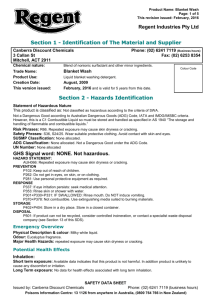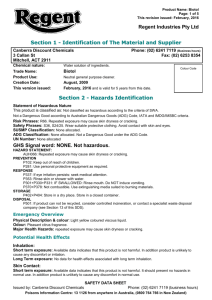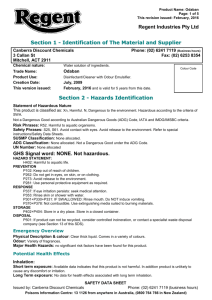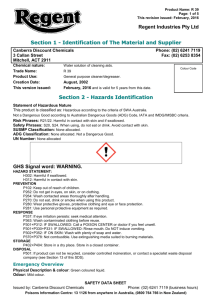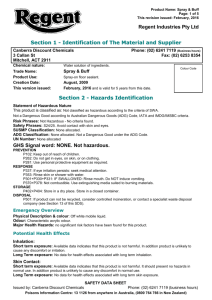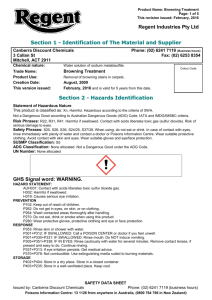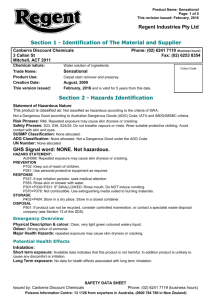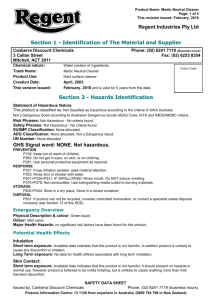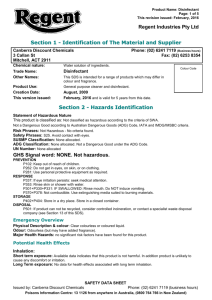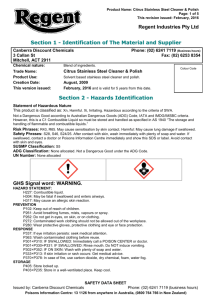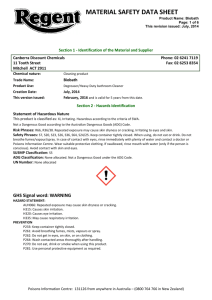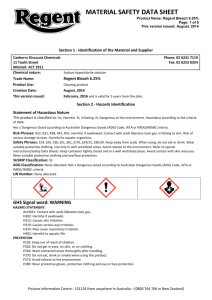Prespray - The Cleaning Warehouse | Discount Chemicals
advertisement
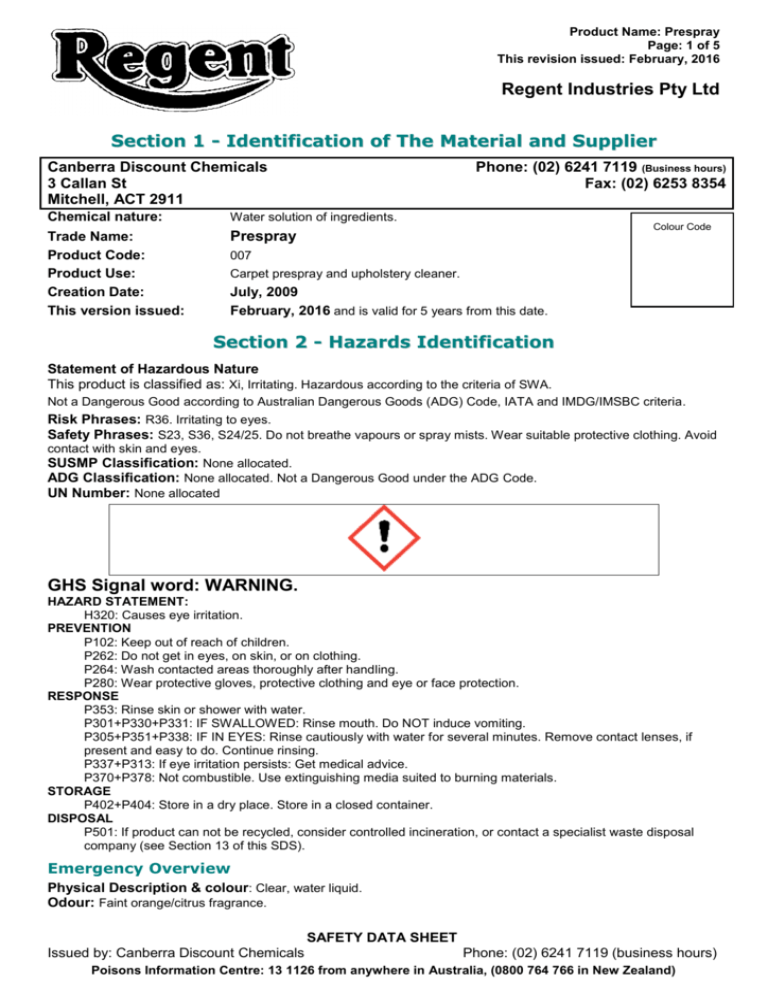
Product Name: Prespray Page: 1 of 5 This revision issued: February, 2016 Regent Industries Pty Ltd Section 1 - Identification of The Material and Supplier Canberra Discount Chemicals 3 Callan St Mitchell, ACT 2911 Phone: (02) 6241 7119 (Business hours) Fax: (02) 6253 8354 Chemical nature: Water solution of ingredients. Trade Name: Product Code: Product Use: Creation Date: This version issued: Prespray Colour Code 007 Carpet prespray and upholstery cleaner. July, 2009 February, 2016 and is valid for 5 years from this date. Section 2 - Hazards Identification Statement of Hazardous Nature This product is classified as: Xi, Irritating. Hazardous according to the criteria of SWA. Not a Dangerous Good according to Australian Dangerous Goods (ADG) Code, IATA and IMDG/IMSBC criteria. Risk Phrases: R36. Irritating to eyes. Safety Phrases: S23, S36, S24/25. Do not breathe vapours or spray mists. Wear suitable protective clothing. Avoid contact with skin and eyes. SUSMP Classification: None allocated. ADG Classification: None allocated. Not a Dangerous Good under the ADG Code. UN Number: None allocated GHS Signal word: WARNING. HAZARD STATEMENT: H320: Causes eye irritation. PREVENTION P102: Keep out of reach of children. P262: Do not get in eyes, on skin, or on clothing. P264: Wash contacted areas thoroughly after handling. P280: Wear protective gloves, protective clothing and eye or face protection. RESPONSE P353: Rinse skin or shower with water. P301+P330+P331: IF SWALLOWED: Rinse mouth. Do NOT induce vomiting. P305+P351+P338: IF IN EYES: Rinse cautiously with water for several minutes. Remove contact lenses, if present and easy to do. Continue rinsing. P337+P313: If eye irritation persists: Get medical advice. P370+P378: Not combustible. Use extinguishing media suited to burning materials. STORAGE P402+P404: Store in a dry place. Store in a closed container. DISPOSAL P501: If product can not be recycled, consider controlled incineration, or contact a specialist waste disposal company (see Section 13 of this SDS). Emergency Overview Physical Description & colour: Clear, water liquid. Odour: Faint orange/citrus fragrance. SAFETY DATA SHEET Issued by: Canberra Discount Chemicals Phone: (02) 6241 7119 (business hours) Poisons Information Centre: 13 1126 from anywhere in Australia, (0800 764 766 in New Zealand) Product Name: Prespray Page: 2 of 5 This revision issued: February, 2016 Major Health Hazards: 2-butoxyethanol is a severe eye irritant. Results of skin irritation studies are conflicting; however, it is considered to be a mild to moderate skin irritant in test animals. Contact dermatitis has been reported in a few cases. It is well absorbed via the inhalational, oral and dermal routes. Potential Health Effects Inhalation: Short term exposure: Available data indicates that this product is not harmful. However product may be mildly irritating, although unlikely to cause anything more than mild transient discomfort. Long Term exposure: No data for health effects associated with long term inhalation. Skin Contact: Short term exposure: Available data indicates that this product is not harmful. It should present no hazards in normal use. However product may be mildly irritating, but is unlikely to cause anything more than mild discomfort which should disappear once contact ceases. Long Term exposure: No data for health effects associated with long term skin exposure. Eye Contact: Short term exposure: This product is an eye irritant. Symptoms may include stinging and reddening of eyes and watering which may become copious. Other symptoms may also become evident. If exposure is brief, symptoms should disappear once exposure has ceased. However, lengthy exposure or delayed treatment may cause permanent damage. Long Term exposure: No data for health effects associated with long term eye exposure. Ingestion: Short term exposure: Significant oral exposure is considered to be unlikely. However, this product may be irritating to mucous membranes but is unlikely to cause anything more than transient discomfort. Long Term exposure: No data for health effects associated with long term ingestion. Carcinogen Status: SWA: No significant ingredient is classified as carcinogenic by SWA. NTP: No significant ingredient is classified as carcinogenic by NTP. IARC: Butyl Icinol is Class 3 - unclassifiable as to carcinogenicity to humans. See the IARC website for further details. A web address has not been provided as addresses frequently change. Section 3 - Composition/Information on Ingredients Ingredients CAS No Conc,% TWA (mg/m3) STEL (mg/m3) Dipropylene glycol methyl ether 34590-94-8 5 308 909 Non hazardous detergents various <10 not set not set Other non hazardous ingredients various <10 not set not set Water 7732-18-5 to 100 not set not set This is a commercial product whose exact ratio of components may vary slightly. Minor quantities of other non hazardous ingredients are also possible. The SWA TWA exposure value is the average airborne concentration of a particular substance when calculated over a normal 8 hour working day for a 5 day working week. The STEL (Short Term Exposure Limit) is an exposure value that may be equalled (but should not be exceeded) for no longer than 15 minutes and should not be repeated more than 4 times per day. There should be at least 60 minutes between successive exposures at the STEL. The term "peak "is used when the TWA limit, because of the rapid action of the substance, should never be exceeded, even briefly. Section 4 - First Aid Measures General Information: You should call The Poisons Information Centre if you feel that you may have been poisoned, burned or irritated by this product. The number is 13 1126 from anywhere in Australia (0800 764 766 in New Zealand) and is available at all times. Have this SDS with you when you call. Inhalation: First aid is not generally required. If in doubt, contact a Poisons Information Centre or a doctor. Skin Contact: Irritation is unlikely. However, if irritation does occur, flush with lukewarm, gently flowing water for 5 minutes or until chemical is removed. Eye Contact: Immediately flush the contaminated eye(s) with lukewarm, gently flowing water for 20 minutes or until the product is removed, while holding the eyelid(s) open. Take care not to rinse contaminated water into the SAFETY DATA SHEET Issued by: Canberra Discount Chemicals Phone: (02) 6241 7119 (business hours) Poisons Information Centre: 13 1126 from anywhere in Australia, (0800 764 766 in New Zealand) Product Name: Prespray Page: 3 of 5 This revision issued: February, 2016 unaffected eye or onto the face. Obtain medical attention immediately. Take special care if exposed person is wearing contact lenses. Ingestion: If product is swallowed or gets in mouth, do NOT induce vomiting; wash mouth with water and give some water to drink. If symptoms develop, or if in doubt contact a Poisons Information Centre or a doctor. Section 5 - Fire Fighting Measures Fire and Explosion Hazards: There is no risk of an explosion from this product under normal circumstances if it is involved in a fire. Only small quantities of decomposition products are expected from this products at temperatures normally achieved in a fire. This will only occur after heating to dryness. Fire decomposition products from this product are likely to be irritating if inhaled. Extinguishing Media: Not Combustible. Use extinguishing media suited to burning materials. Fire Fighting: If a significant quantity of this product is involved in a fire, call the fire brigade. Flash point: Does not burn. Upper Flammability Limit: Does not burn. Lower Flammability Limit: Does not burn. Autoignition temperature: Not applicable - does not burn. Flammability Class: Does not burn. Section 6 - Accidental Release Measures Accidental release: In the event of a major spill, prevent spillage from entering drains or water courses. Wear full protective clothing including eye/face protection. All skin areas should be covered. See below under Personal Protection regarding Australian Standards relating to personal protective equipment. Suitable materials for protective clothing include rubber, PVC. Eye/face protective equipment should comprise as a minimum, protective glasses and, preferably, goggles. If there is a significant chance that vapours or mists are likely to build up in the cleanup area, we recommend that you use a respirator. Usually, no respirator is necessary when using this product. However, if you have any doubts consult the Australian Standard mentioned below (section 8). Stop leak if safe to do so, and contain spill. Absorb onto sand, vermiculite or other suitable absorbent material. If spill is too large or if absorbent material is not available, try to create a dike to stop material spreading or going into drains or waterways. Sweep up and shovel or collect recoverable product into labelled containers for recycling or salvage, and dispose of promptly. Recycle containers wherever possible after careful cleaning. After spills, wash area preventing runoff from entering drains. If a significant quantity of material enters drains, advise emergency services. This material may be suitable for approved landfill. Ensure legality of disposal by consulting regulations prior to disposal. Thoroughly launder protective clothing before storage or re-use. Advise laundry of nature of contamination when sending contaminated clothing to laundry. Section 7 - Handling and Storage Handling: Keep exposure to this product to a minimum, and minimise the quantities kept in work areas. Check Section 8 of this SDS for details of personal protective measures, and make sure that those measures are followed. The measures detailed below under "Storage" should be followed during handling in order to minimise risks to persons using the product in the workplace. Also, avoid contact or contamination of product with incompatible materials listed in Section 10. Storage: Store packages of this product in a cool place. Make sure that containers of this product are kept tightly closed. Keep containers dry and away from water. Make sure that the product does not come into contact with substances listed under "Incompatibilities" in Section 10. Some liquid preparations settle or separate on standing and may require stirring before use. Check packaging - there may be further storage instructions on the label. Section 8 - Exposure Controls and Personal Protection The following Australian Standards will provide general advice regarding safety clothing and equipment: Respiratory equipment: AS/NZS 1715, Protective Gloves: AS 2161, Occupational Protective Clothing: AS/NZS 4501 set 2008, Industrial Eye Protection: AS1336 and AS/NZS 1337, Occupational Protective Footwear: AS/NZS2210. SWA Exposure Limits TWA (mg/m3) STEL (mg/m3) Dipropylene glycol methyl ether 308 909 No special equipment is usually needed when occasionally handling small quantities. The following instructions are for bulk handling or where regular exposure in an occupational setting occurs without proper containment systems. Ventilation: No special ventilation requirements are normally necessary for this product. However make sure that the work environment remains clean and that vapours and mists are minimised. SAFETY DATA SHEET Issued by: Canberra Discount Chemicals Phone: (02) 6241 7119 (business hours) Poisons Information Centre: 13 1126 from anywhere in Australia, (0800 764 766 in New Zealand) Product Name: Prespray Page: 4 of 5 This revision issued: February, 2016 Eye Protection: Protective glasses or goggles should be worn when this product is being used. Failure to protect your eyes may cause them harm. Emergency eye wash facilities are also recommended in an area close to where this product is being used. Skin Protection: The information at hand indicates that this product is not harmful and that normally no special skin protection is necessary. However, we suggest that you routinely avoid contact with all chemical products and that you wear suitable gloves (preferably elbow-length) when skin contact is likely. Protective Material Types: We suggest that protective clothing be made from the following materials: rubber, PVC. Respirator: Usually, no respirator is necessary when using this product. However, if you have any doubts consult the Australian Standard mentioned above. Eyebaths or eyewash stations and safety deluge showers should be provided near to where this product is being used. Section 9 - Physical and Chemical Properties: Physical Description & colour: Odour: Boiling Point: Freezing/Melting Point: Volatiles: Vapour Pressure: Vapour Density: Specific Gravity: Water Solubility: pH: Volatility: Odour Threshold: Evaporation Rate: Coeff Oil/water distribution: Autoignition temp: Clear, water liquid. Faint orange/citrus fragrance. Approximately 100°C at 100kPa. Approximately 0°C. Water component. 2.37 kPa at 20°C (water vapour pressure). No data. No data. Expected to be about 1.0 Completely soluble in water. 7.0 No data. No data. No data. No data Not applicable - does not burn. Section 10 - Stability and Reactivity Reactivity: This product is unlikely to react or decompose under normal storage conditions. However, if you have any doubts, contact the supplier for advice on shelf life properties. Conditions to Avoid: This product should be kept in a cool place, preferably below 30°C. Keep containers tightly closed. Containers should be kept dry. Incompatibilities: No particular Incompatibilities. Fire Decomposition: Only small quantities of decomposition products are expected from this products at temperatures normally achieved in a fire. This will only occur after heating to dryness. Carbon dioxide, and if combustion is incomplete, carbon monoxide and smoke. Water. Carbon monoxide poisoning produces headache, weakness, nausea, dizziness, confusion, dimness of vision, disturbance of judgment, and unconsciousness followed by coma and death. Polymerisation: This product will not undergo polymerisation reactions. Section 11 - Toxicological Information There is no data to hand indicating any particular target organs. Toxicity: 2-butoxyethanol is a severe eye irritant. Results of skin irritation studies are conflicting; however, it is considered to be a mild to moderate skin irritant in test animals. Contact dermatitis has been reported in a few cases. It is well absorbed via the inhalational, oral and dermal routes. Classification of Hazardous Ingredients Ingredient Risk Phrases No ingredient mentioned in the HSIS Database is present in this product at hazardous concentrations. Section 12 - Ecological Information This product is biodegradable. It will not accumulate in the soil or water or cause long term problems. SAFETY DATA SHEET Issued by: Canberra Discount Chemicals Phone: (02) 6241 7119 (business hours) Poisons Information Centre: 13 1126 from anywhere in Australia, (0800 764 766 in New Zealand) Product Name: Prespray Page: 5 of 5 This revision issued: February, 2016 Section 13 - Disposal Considerations Disposal: This product may be recycled if unused, or if it has not been contaminated so as to make it unsuitable for its intended use. If it has been contaminated, it may be possible to separate the contamination in some way. Only if neither of these options is suitable, consider landfill. Section 14 - Transport Information ADG Code: This product is not classified as a Dangerous Good by ADG, IATA or IMDG/IMSBC criteria. No special transport conditions are necessary unless required by other regulations. Section 15 - Regulatory Information AICS: All of the significant ingredients in this formulation are compliant with NICNAS regulations. The following ingredient: Butyl icinol, is mentioned in the SUSMP. Section 16 - Other Information This SDS contains only safety-related information. For other data see product literature. Acronyms: ADG Code AICS SWA CAS number Hazchem Code IARC NOS NTP R-Phrase SUSMP UN Number Australian Code for the Transport of Dangerous Goods by Road and Rail (7 th edition) Australian Inventory of Chemical Substances Safe Work Australia, formerly ASCC and NOHSC Chemical Abstracts Service Registry Number Emergency action code of numbers and letters that provide information to emergency services especially firefighters International Agency for Research on Cancer Not otherwise specified National Toxicology Program (USA) Risk Phrase Standard for the Uniform Scheduling of Medicines & Poisons United Nations Number THIS SDS SUMMARISES OUR BEST KNOWLEDGE OF THE HEALTH AND SAFETY HAZARD INFORMATION OF THE PRODUCT AND HOW TO SAFELY HANDLE AND USE THE PRODUCT IN THE WORKPLACE. EACH USER MUST REVIEW THIS SDS IN THE CONTEXT OF HOW THE PRODUCT WILL BE HANDLED AND USED IN THE WORKPLACE. IF CLARIFICATION OR FURTHER INFORMATION IS NEEDED TO ENSURE THAT AN APPROPRIATE RISK ASSESSMENT CAN BE MADE, THE USER SHOULD CONTACT THIS COMPANY SO WE CAN ATTEMPT TO OBTAIN ADDITIONAL INFORMATION FROM OUR SUPPLIERS OUR RESPONSIBILITY FOR PRODUCTS SOLD IS SUBJECT TO OUR STANDARD TERMS AND CONDITIONS, A COPY OF WHICH IS SENT TO OUR CUSTOMERS AND IS ALSO AVAILABLE ON REQUEST. Please read all labels carefully before using product. This SDS is prepared in accord with the SWA document “Preparation of Safety Data Sheets for Hazardous Chemicals - Code of Practice” (December 2011) Copyright © Kilford & Kilford Pty Ltd, February, 2016. http://www.kilford.com.au/ Phone (02)9251 4532 SAFETY DATA SHEET Issued by: Canberra Discount Chemicals Phone: (02) 6241 7119 (business hours) Poisons Information Centre: 13 1126 from anywhere in Australia, (0800 764 766 in New Zealand)
